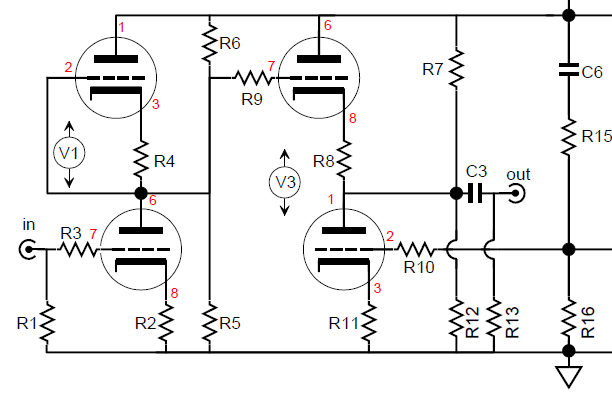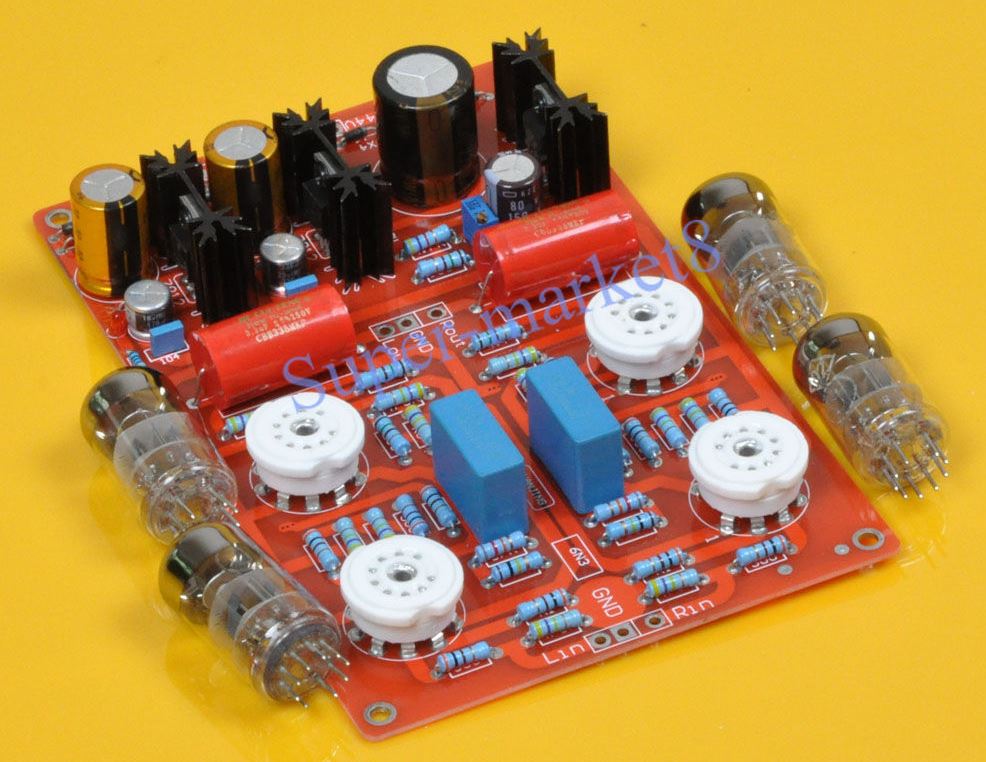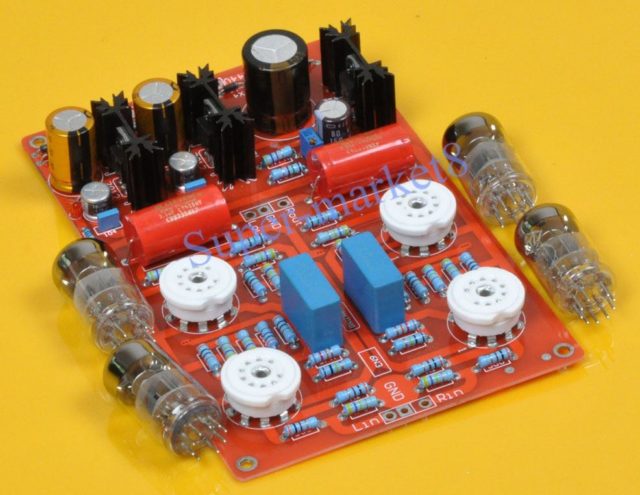Battle of the Cheap Line Stages – Part 2 of a DIY Showdown
Review by Steve Graham
The Asian Contender:
6N3 4pcs Audio Tube Pre-Amplifier Preamp Board Assembled Kit DIY, aka “Yuanjing”
Yeah, bit of a mouthful, but that’s how it was described in the eBay ad I bought it from. The amp you see in the picture cost $39.99 US plus $12 for shipping. There must have been a production overrun of tens of thousands of 6N3 tubes that some entrepreneur picked up at a very low price. Someone in China must be churning these out by the thousands to get the price this low. The only identifier I see on the board, aside from 6N3, is “Yuanjing” so henceforth I shall refer to it as that.
What is a 6N3, you ask? It’s a small dual-triode that is more less equivalent to the North American 5670 and 2C51. These tubes do not have the same pinout as the more common 12AX7 or 6DJ8 tubes, which probably explains the large and relatively cheap NOS stocks. NOS 5670’s are priced starting at about $12 each. The board comes assembled as shown in the picture.
The tubes tested somewhat indifferently on my admittedly crude Eico 666 tube tester. One tube tested OK, another had poorly balanced sections, a third had very slight heater-cathode leaks in both sections, but the sections matched reasonably well, and the fourth had one section with a significant heater-cathode leak. Not a very confidence-inspiring start.
Here’s a source for NOS North American-made 5670 tubes: http://www.thetubestore.com/Tubes/2-Types/NOS-5670-2C51
The board quality of the Yuanjing looks to be not bad, but the plated through holes connecting traces from one side to the other look a bit light-weight. These traces are mostly for the filament runs and will see quite a bit of current; this could be a point of failure. Running a finger nail over a trace on the Aikido board and then on the Yuanjing board reveals that the copper on the Aikido is thicker. The glass fiber board is 1.5mm thick and there are four mounting holes, one at each corner. It would be nice to have another hole along each side to minimise flexing when inserting or removing tubes.
The parts quality appears reasonable for the price. There is a combination of name-brand and no-name capacitors. The resistors appear to be decent enough metal film and carbon film types. The rectifier diodes are generic 1N4007’s; you don’t get low noise, fast recovery types at this price point. The three voltage regulators are all brand name parts.
The circuit topology is not that easy to determine as a schematic was not included. I decided to perform a little electrical archeology to satisfy my curiosity and I found an old friend: the Aikido! The reason I decided to switch it up and build this amp second (aside from the fact that I was waiting on a replacement for the bad tube) is that I wanted to present the original Aikido first.
For those interested, you’ll see a basic schematic of the Aikido circuit below. Most of the Aikido circuits are covered by copyright when published in the manuals supplied with the kits. This one has been freely available for download on the Tubecad website, so I’m reproducing it here for those interested. The combination of C6, R15, R10 and R16 is the power supply noise cancelling part of the circuit I mentioned in Part 1. More can be read about this feature on the Tubecad website.

The Yuanjing 6N3 circuit is a dead ringer for the published Aikido circuit above. Many boards available from the Far East appear to be just rehashed circuits from half a century or so ago. In a way I’m pleased to see this. If someone is going to copy a circuit, it might as well be something worthwhile.
Like the authentic Aikido in the first installment, the Yuanjing board contains the power supplies (less transformers) for both filament and high voltage. Two transformers, one each for filament and high voltage (B+), are required. Two small toroidal transformers cost about $50 – so the initial price for the board doesn’t seem quite so reasonable, especially as the real Aikido profiled in part 1 requires only one. So tack on another 25 bucks to the cost of getting this one up and running.
The power supply part of the board has two regulated filament supplies. This is done to split the current load over two voltage regulators, therefore avoiding heat dissipation issues if one regulator had been used. The high voltage section is regulated as well but this is limited to about 50 volts DC. I suspect 50 volts is low for this particular tube in an Aikido circuit.
According to the markings on the board and in the eBay ad the secondary of the filament transformer should output between 12 and 15 volts at 20 watts (about 1.7 amps). On first power up with a nominally 14 volt transformer (12 to 14 volts recommended), the two voltage regulators for the filaments became quite hot. The transformer secondary measured over 16 volts and the regulators were struggling to burn off the excess power. Two 1.8 ohm resistors were added between the transformer and the board with the result that the regulators were much cooler. A maximum nominal 12 volt secondary would be best. There are components placed too close to the heatsinks to allow proper air flow.
The B+ transformer should output 40 and 44 volts at 10 watts (about 250 milliamps). I connected a nominal 44 volt transformer but the rectified DC exceeded the 63 volt rating of the first capacitor after the rectifiers. I switched to a 36 volt transformer and the rectified DC dropped to about 60 volts. The filter capacitor after the regulator is rated at 50 volts. There is a trimmer pot in the regulator circuit and adjusting it for maximum voltage exceeds the rating of the second capacitor. Removing this cap, I saw that according to the part info screened on the board, it should be rated at 63 volts. I installed a 63 volt rated cap from my stash of parts. This allowed me to max out the B+ to about 57 volts. This then exceed the voltage rating of another 50 volt rated cap in the power supply. If you are getting frustrated reading this, then you will have a sense of the frustration I was experiencing.
With the B+ fully cranked, willingly ignoring the capacitor voltage ratings, I set about to measure the operating voltages on the tubes and calculate the dissipated power. To make a long story short, these tubes (6N3 and their North American equivalents) are, as I previously suspected, unsuitable for operation in the 50 volt range. The current drawn by the tubes is very low and as a result the power dissipated is a very, very small proportion of their maximum rating. This implies that the tubes might not be operating in their linear region, and distortion may result. I suspect a B+ supply of at least 150 volts would be required to get these tubes into their correct operating range.
Listening Impressions, substituting the Yuanjing for the Audio Research Reference 3:
After my usual break-in cycle, I connected up the Yuanjing in place of the ARC Ref 3, just to make sure it was working properly and not doing anything odd. I played 2 or 3 of my standard auditioning tracks mentioned back in Part 1 of this article. In isolation, the Yuanjing didn’t sound too bad, considering that I think it is a substandard implementation of the Aikido design. The bass was a bit indistinct and muddy and in general music was not very engaging but it didn’t seem seriously flawed.
I connected the Ref 3 back into the system and refreshed my memory of the audition tracks. The Yuanjing was then connected, and the audition tracks played again. The Ref 3 and the Aikido profiled in Part 1 play with good pace and rhythm. By that I mean, the bass keeps pace with the rest of the music and helps propel it along. The Ref 3 is slightly better in this regard than the Aikido. Where the Ref 3 really excels is its combination of pace and rhythm and deep bass extension. The Aikido is a bit rolled-off compared to the Ref 3 but its good pace and rhythm ‘save’ it and make it engaging to listen to none the less.
The bass of the Yuanjing seems deep, but this I think this is an artefact of it being slow and indistinct. The Yuanjing bass lags behind the music and its muddiness, lack of detail and imprecision seem to slow the music down. In general the Yuanjing is a lower resolution device than the real Aikido. It also seems congested in complex musical passages. The soundstage seems flattened too, so there is little if any depth behind the plane of the speakers.
How much of this can be attributed to the sub-optimal implementation of the tubes mentioned earlier is difficult to say, however I suspect a great deal of it can.
Conclusions:
If I was looking for a project (I’m not, I have lots of others waiting for me), I’d pursue the Yuanjing further. In its’ current state, I think even buying a good set of tubes for it would be throwing good money after bad. I am therefore suspending further work on the Yuanjing. I’m just not prepared to spend time trying to make it reasonably musical. As well, this would take me outside of the scope of work I’d planned for these projects, namely a minimally experimental way to a decent line stage.
Adding up the $40 cost (in US dollars) of the Yuanjing plus another $65 dollars for decent tubes (two of the four 6N3 tubes supplied are essentially throw-aways), plus another $20 dollars for a second power transformer, brings it to within $40 of the cost of the real Aikido with tubes, as described in Part 1. Is the much better sound quality of the real Aikido worth the extra $40 US (~$52 Canadian)? The real Aikido is worth at least four times that difference, any day.
I was hoping the Yuanjing would prove worthy of our (us audiophiles) attention, and prove to be a decent entry level circuit. It is not.
~~~
I don’t want to end on a down note, so as mentioned in the preview, I’ll be offering the Aikido as shown in Part 1 for sale. The ‘N-F-P’ laser engraved on the top cover stands for Not-For-Profit. The full sale price less shipping will be donated to the Georgian Bay General Hospital in Midland, Ontario, for their capital equipment renewal fund. As I write this, my local hospital is fund-raising to buy a new CT scanner, at a cost of 1.5 million dollars. This sounds like a lot of money for an institution that serves a population base of 55,000, but the community has raised more than this before for other worthy hospital projects. You may think that I live in the sticks, and you’d be right to a degree, but northern Simcoe County has a summer influx that nearly quadruples our year-round population to 200,000. The GBGH emergency department often treats more patients from the “May two-four” weekend to Labour Day, than the ER’s of some of the Toronto hospitals! The lucky buyer of the Aikido (aka N-F-P) line stage will even get a receipt from GBGH that will make their purchase a tax deductible charitable donation.
I’ll even throw in a few choice NOS parts from my stash of goodies at no extra charge. If need be, I’ll show up at your house and detail your car if that’s what it takes to make a sale.
As soon as I add up what I’ve spent, there will be an announcement on WoS.
Next Time:
In Part 3, I’ll present a cost breakdown, so you can decide if the Aikido as I’ve built it will fit your budget. I’ll also have the drawings ready (sketches really), that will enable you to take the bits and pieces of an eBay-sourced chassis to a local tool and die shop for machining.



I’ve really been enjoying this series/write-up. I’m very much looking forward to the (promised) details about your experiences building the Aikido.
I’ve been a DIY fanboy for a while now, and despite my research & some discussions, I don’t have any build(s) of my own to boast about (that’s actually getting a little embarrassing for me!). I’m finding that information about “basics” like – chassis layout that minimizes noise; testing the circuit; internal wiring; etc. are not typically covered in the DIY forums. So for myself, at least, I would hope that you’re going to touch on those matters (or provide links).
In any case, I’m looking forward to the next installment.
I find this fascinating – who would imagine the humble buffers would/could be so tricky
James,
Thank you for your comment and interest in Wall of Sound. The Aikido circuit may be humble but like most it needs proper implementation (see part 1 of the series). If you are tempted to try DIY the Aikido line stage as done by John Broskie, aka Mr. Tubecad.com, is an excellent way to start. If you follow the plans laid out in parts 3 and 4 of the series I can virtually guarantee success.
The fellow that bought the first N-F-P is in the process of building an all out Aikido line stage with regulated power supplies and fancy parts. He’s that enamoured of the sound of the “baby” Aikido.
Regards, Steve Graham
Great article, Am wondering if you’ve had time to try and if possible recommend any of the other Asian offerings.
Looking forward to reading your next write up.
Thank you for your comment Mr. Price. Other than an Elekit (no write up from me but reviewed by Noam) and a SunValley a month or so ago, both recommendable, I haven’t tried any more Asian offerings from eBay or elsewhere. Once burned….. There’s a reason they sell for less. As Meatloaf said (or words to this effect), “You won’t find a Coupe Deville at the bottom of a Cracker Jack box.”
Regards, Steve Graham